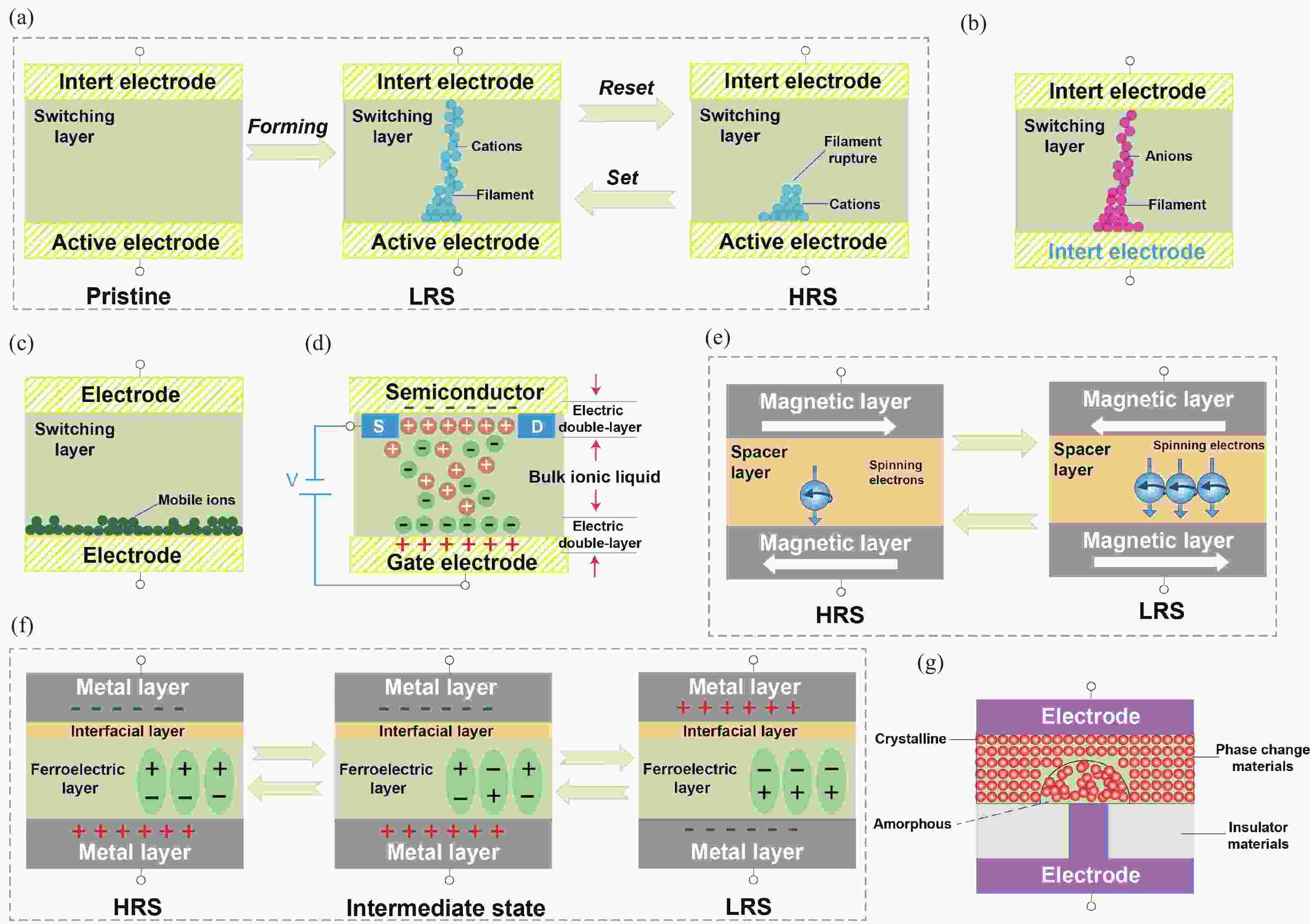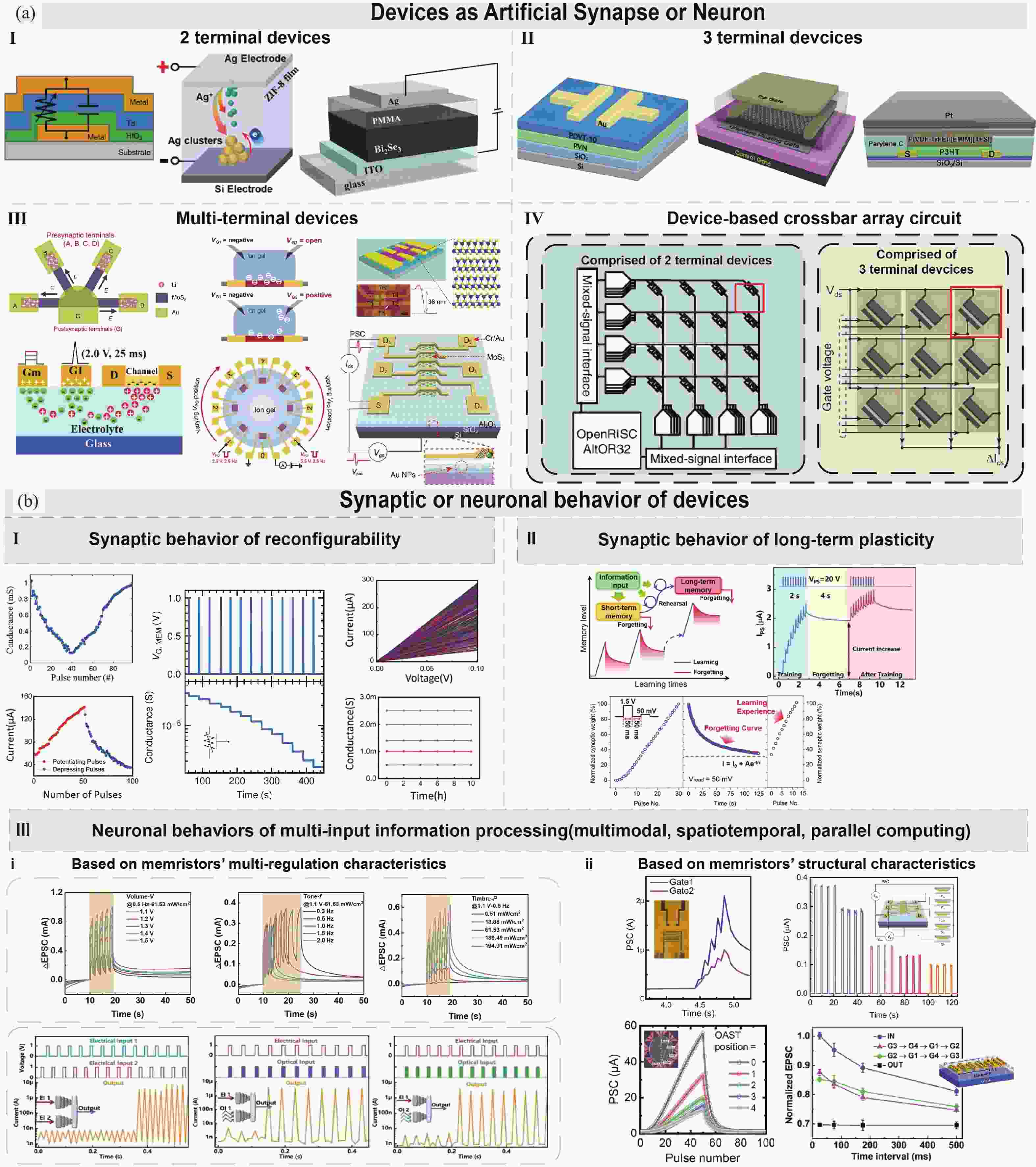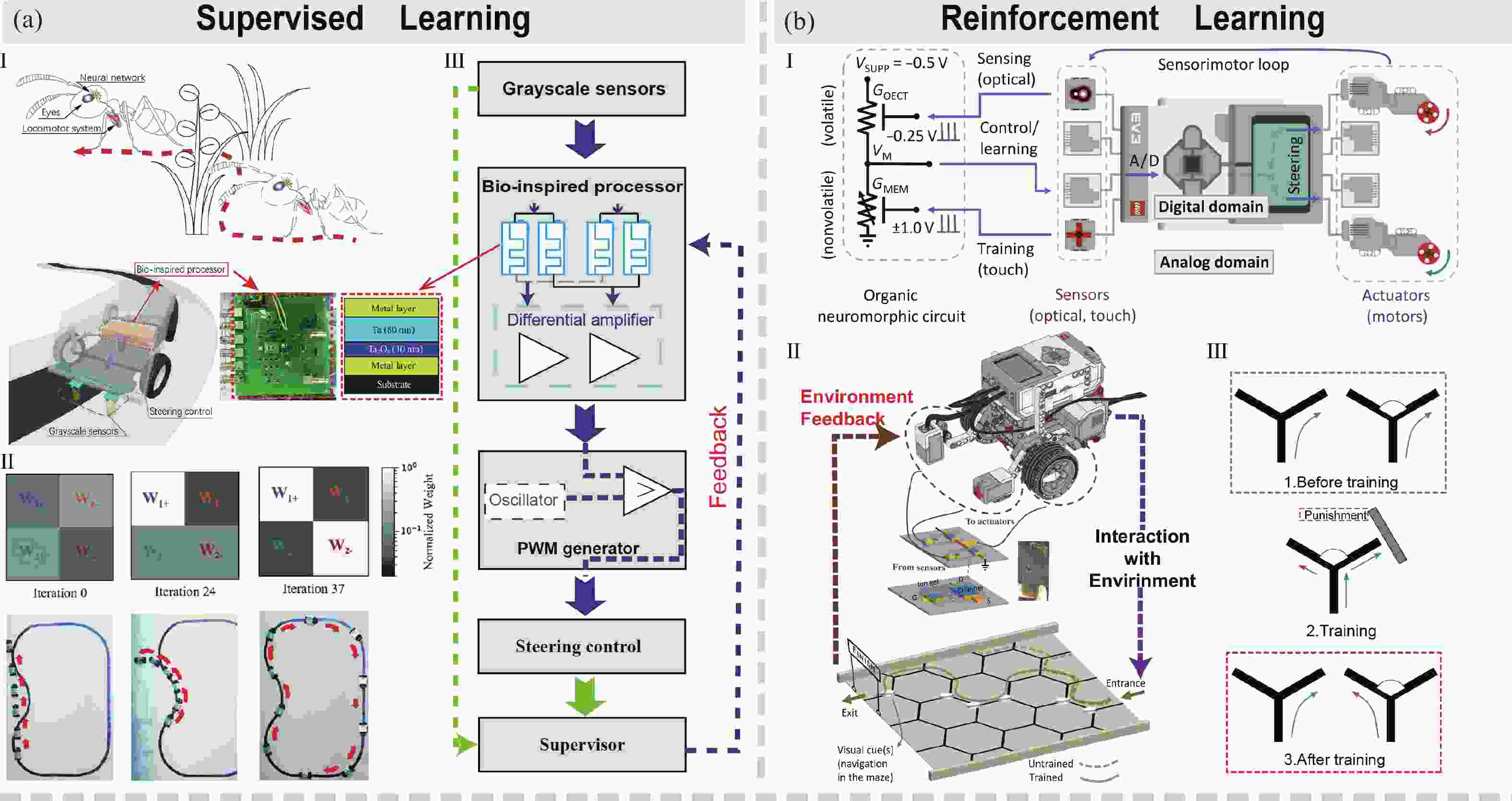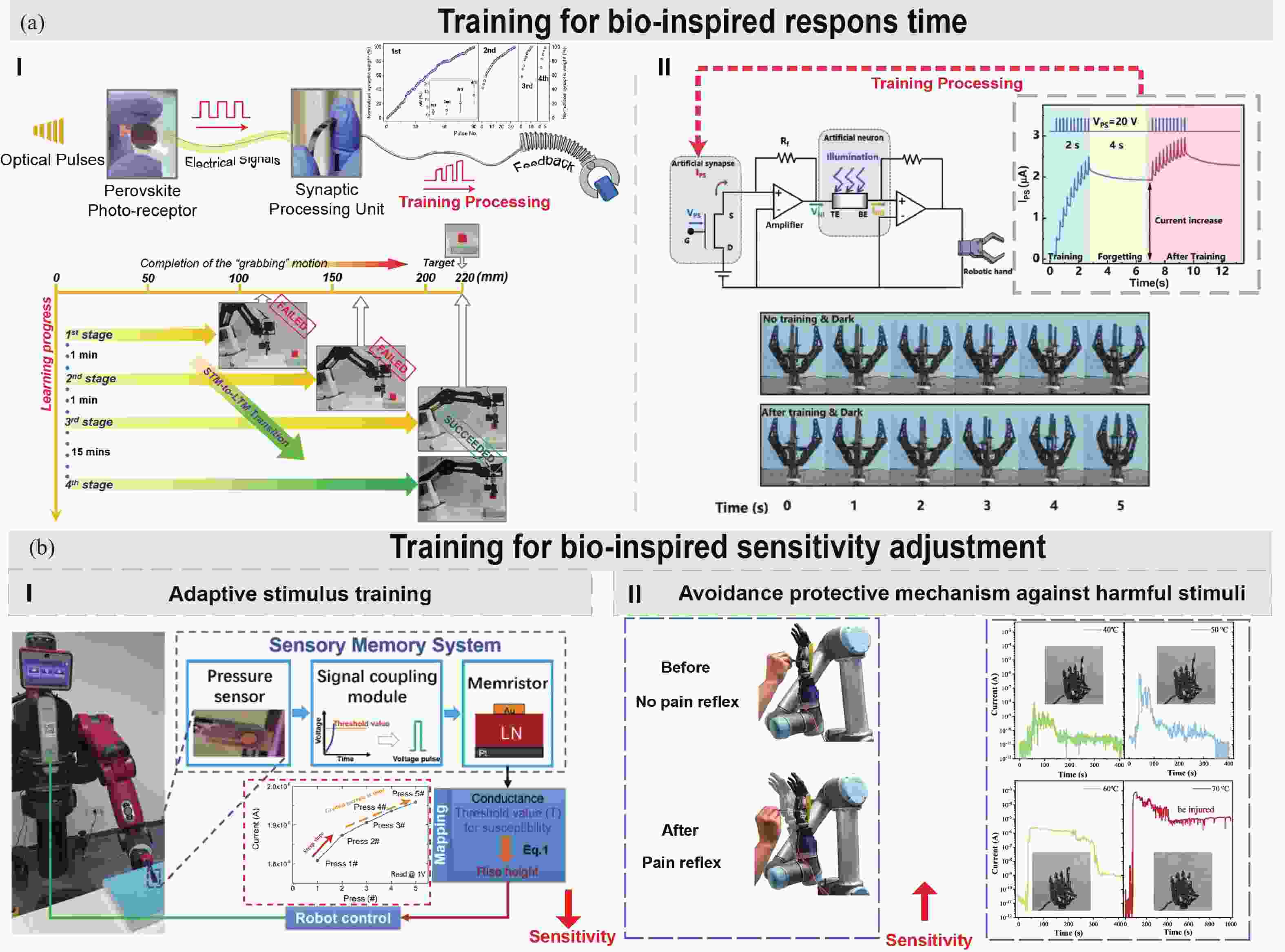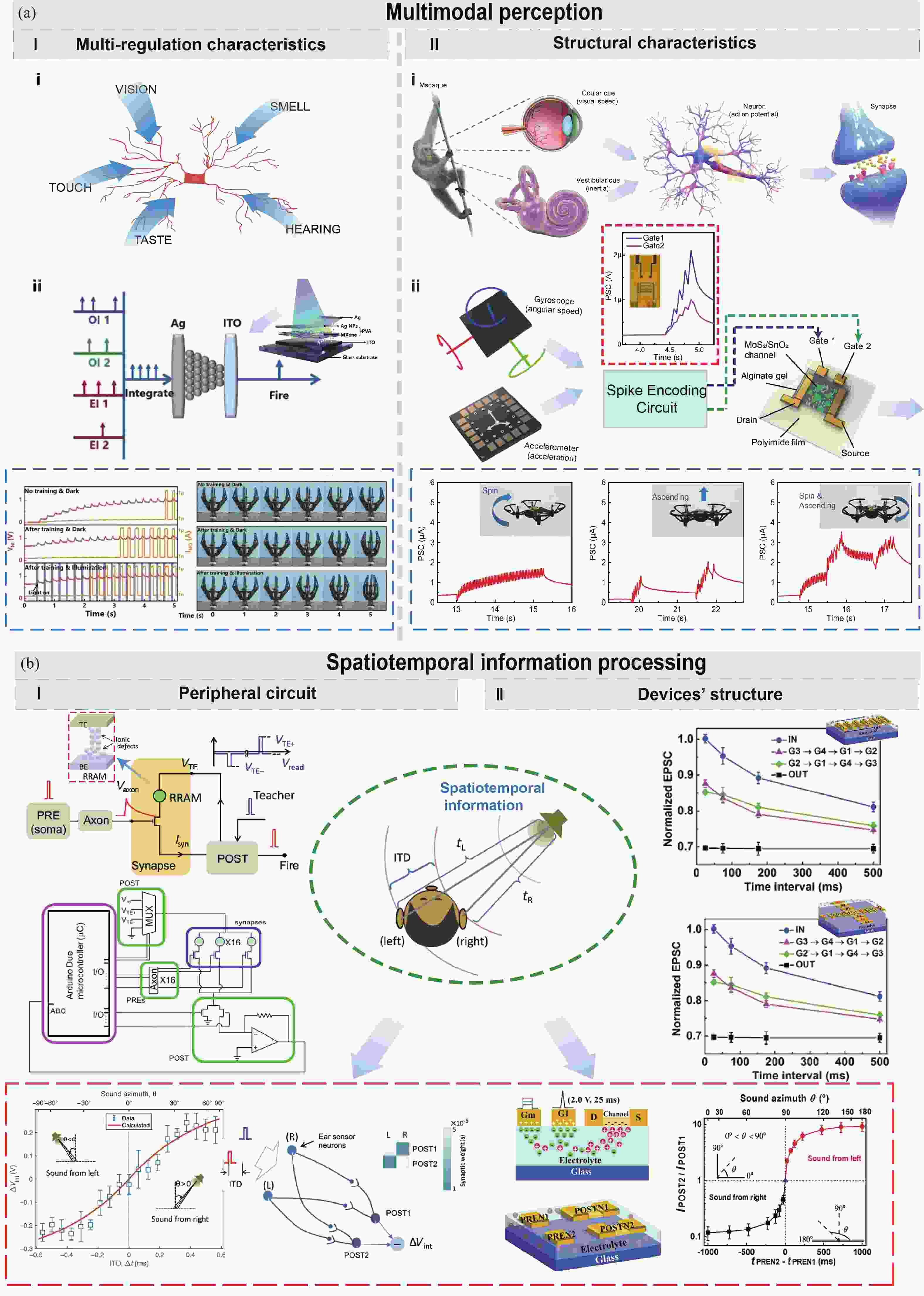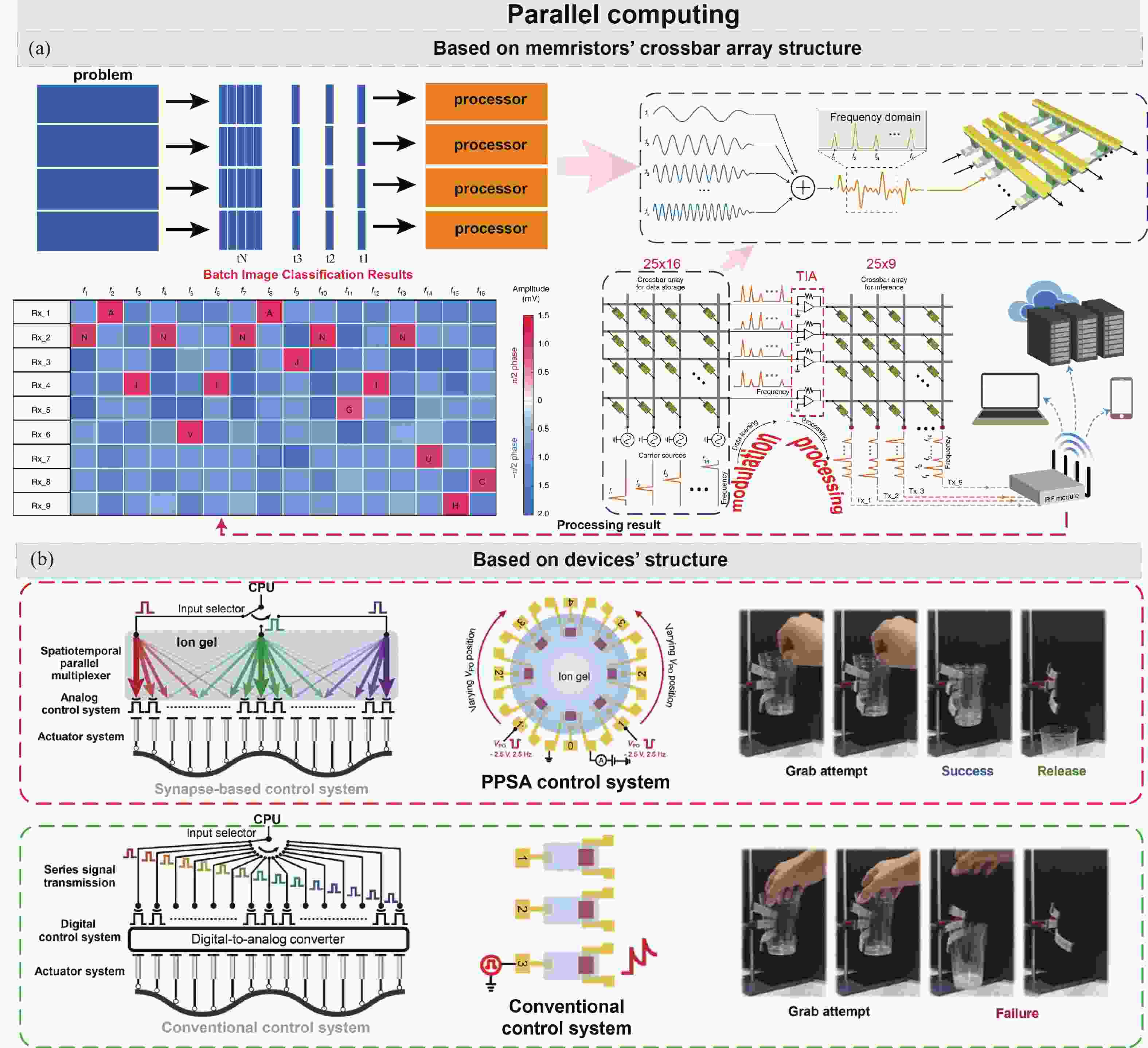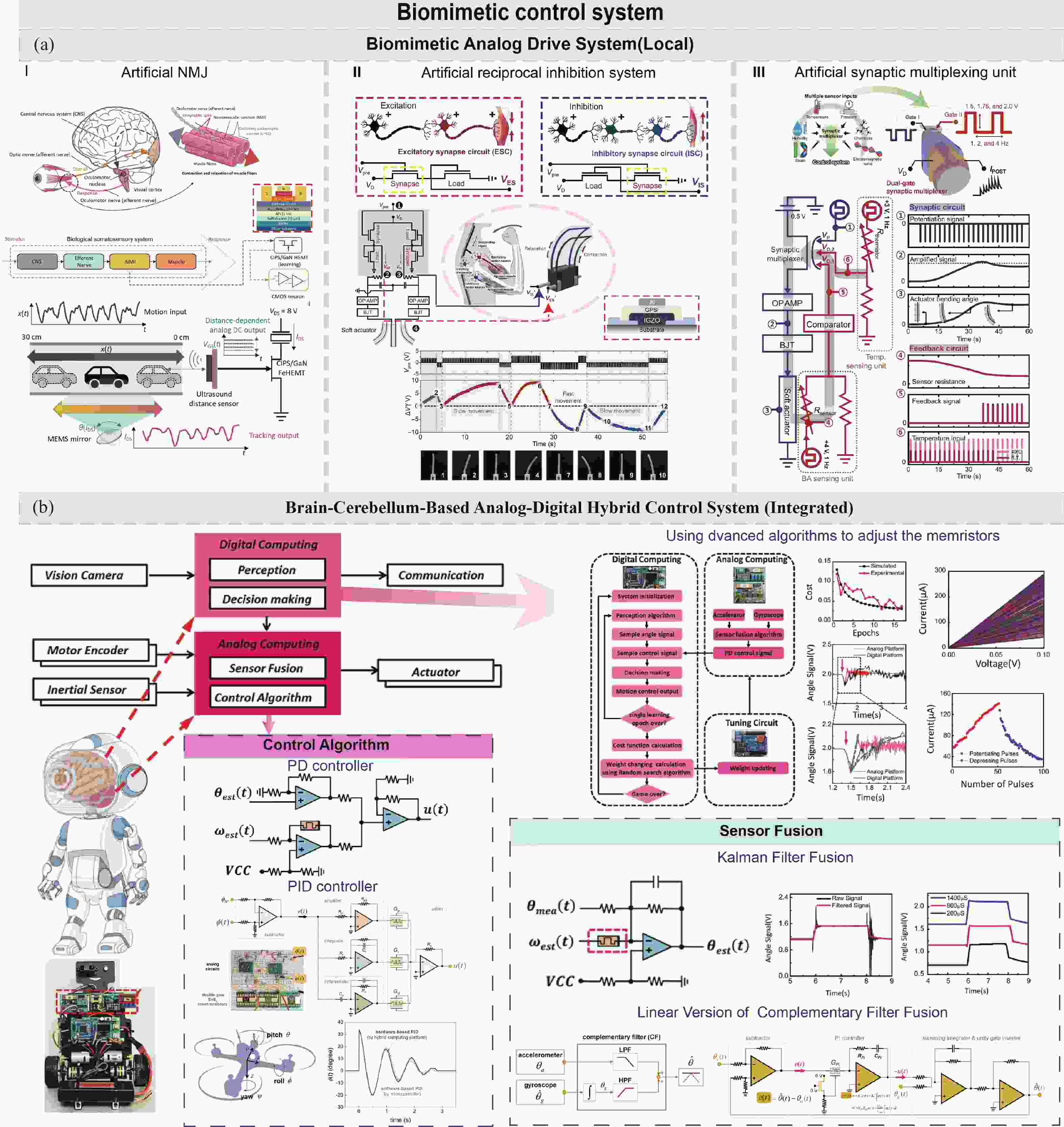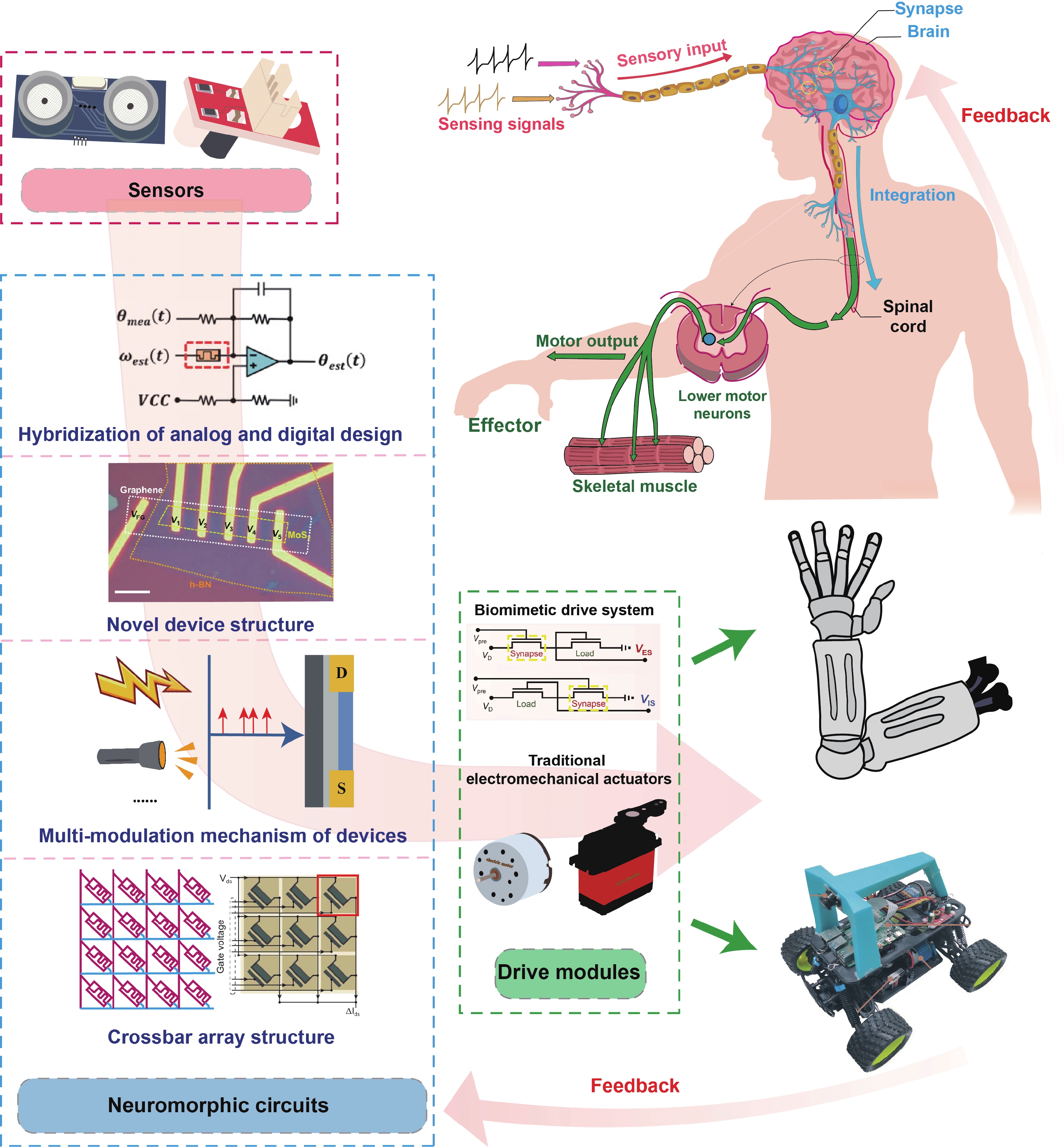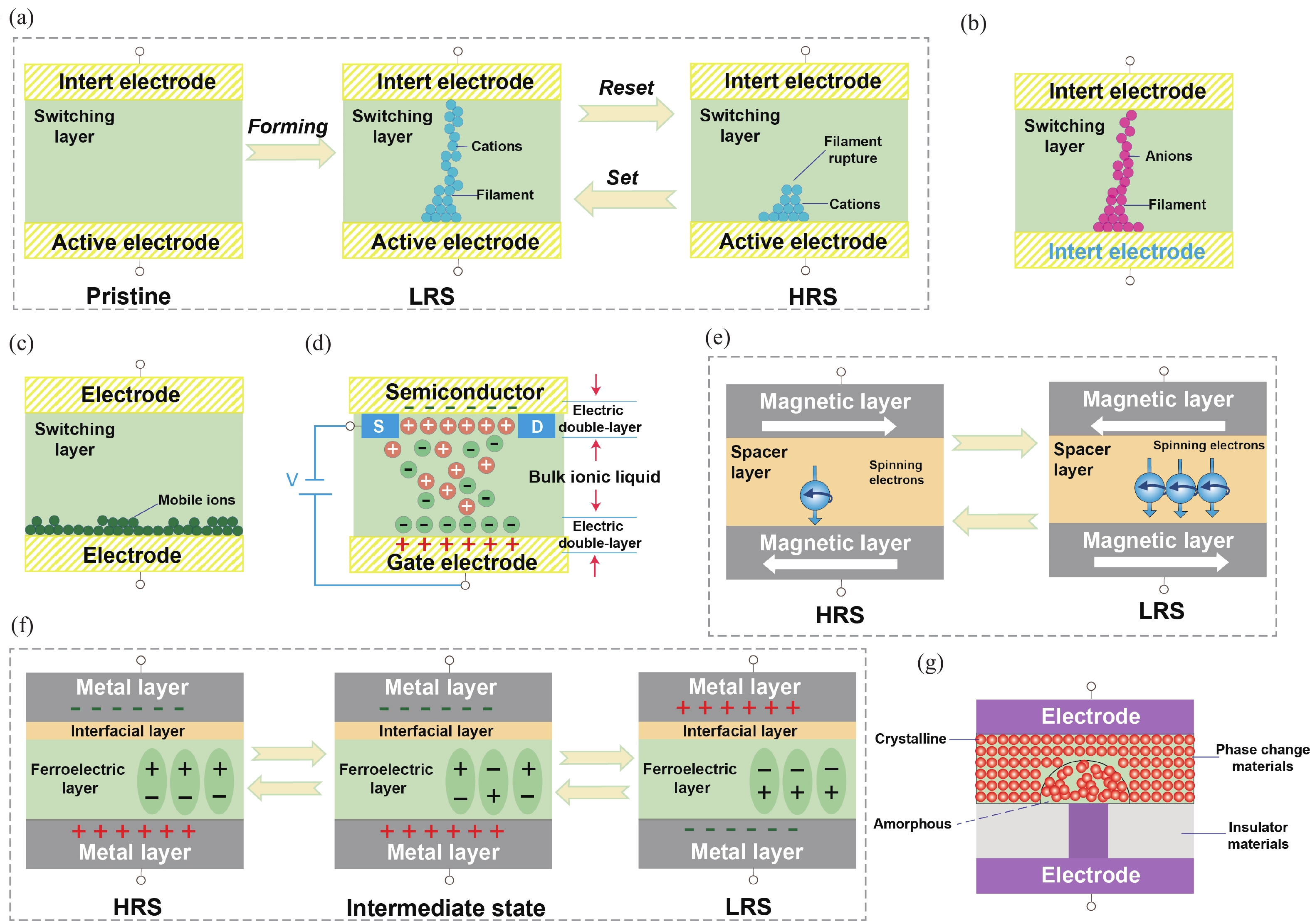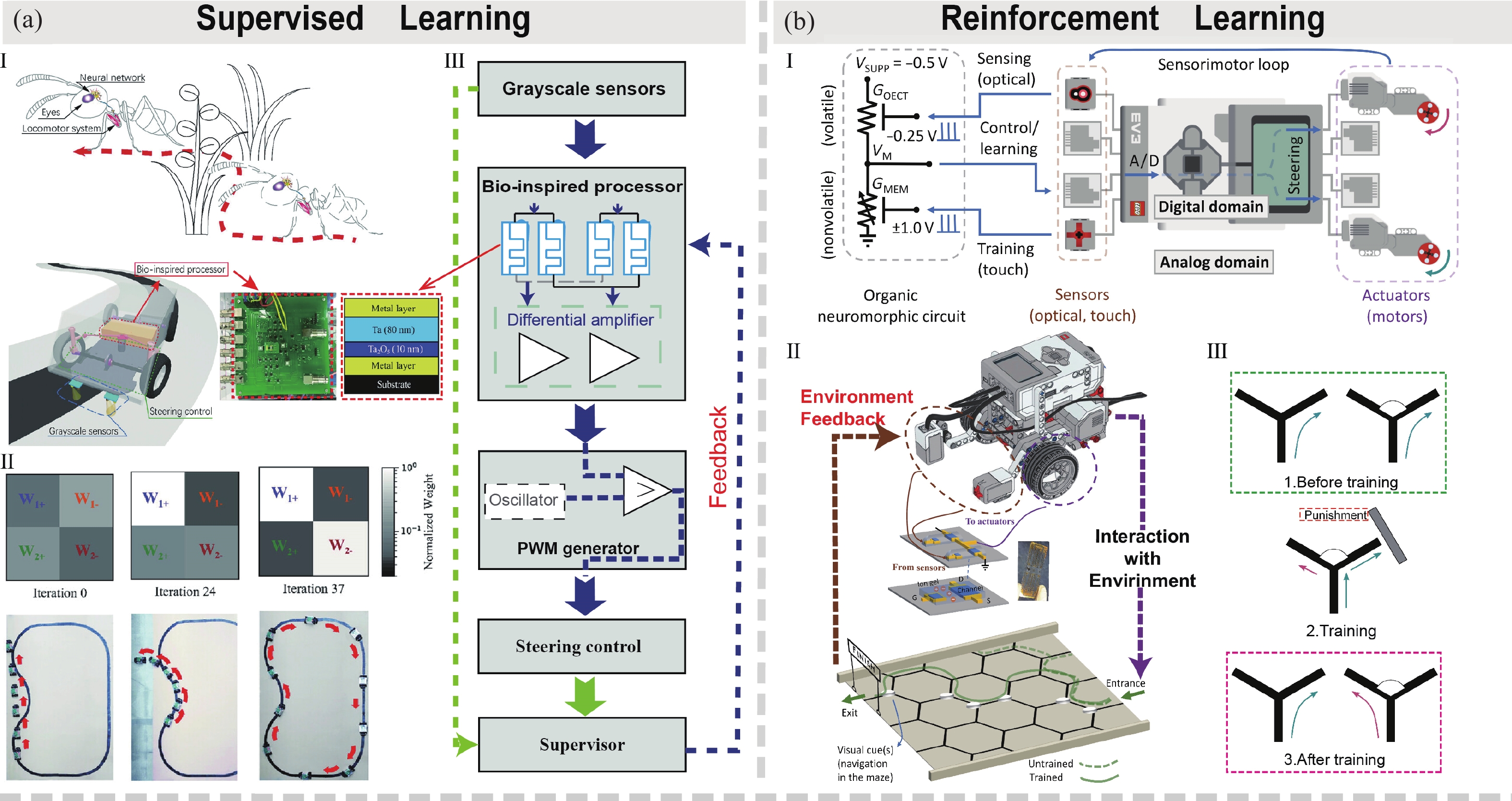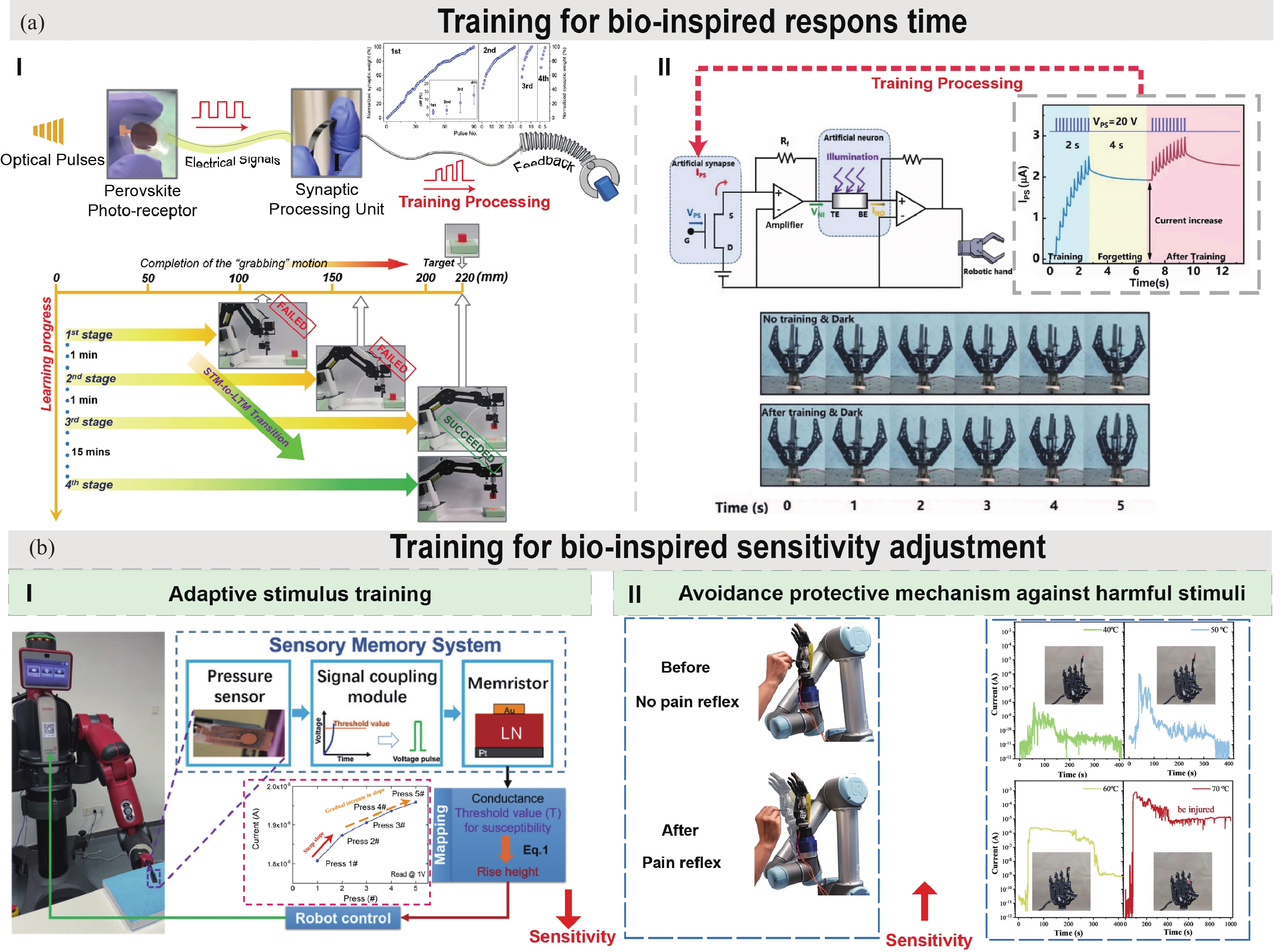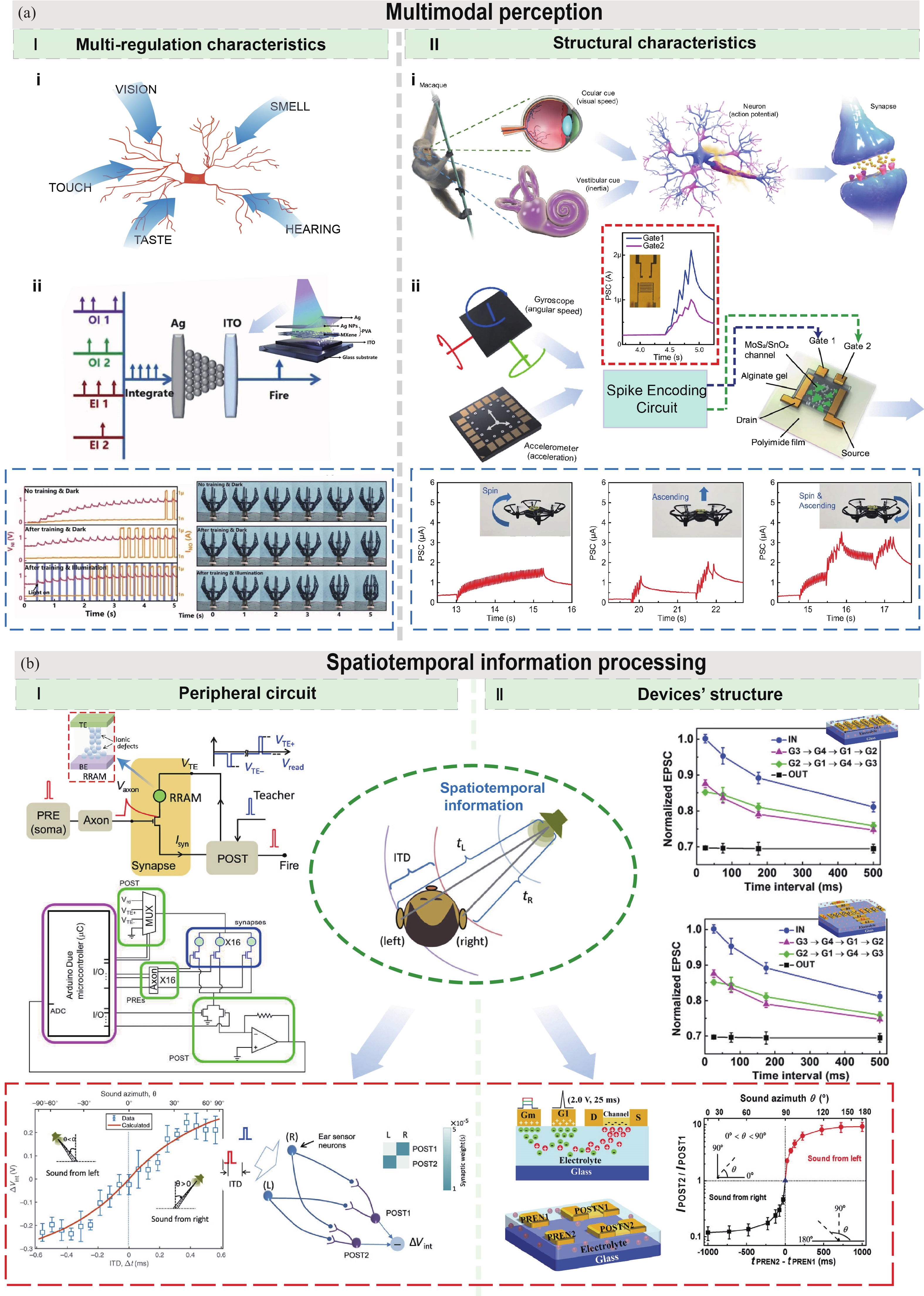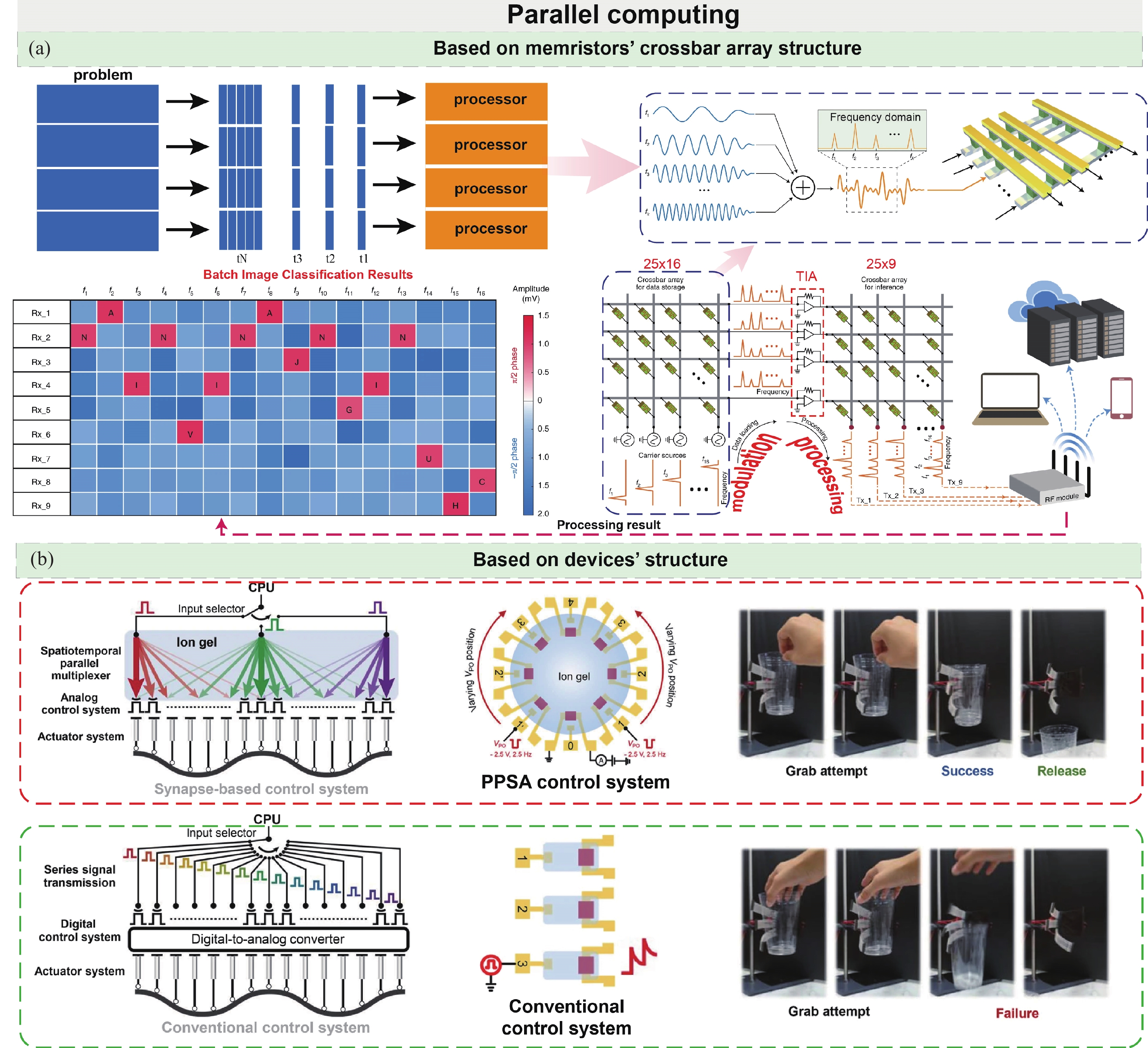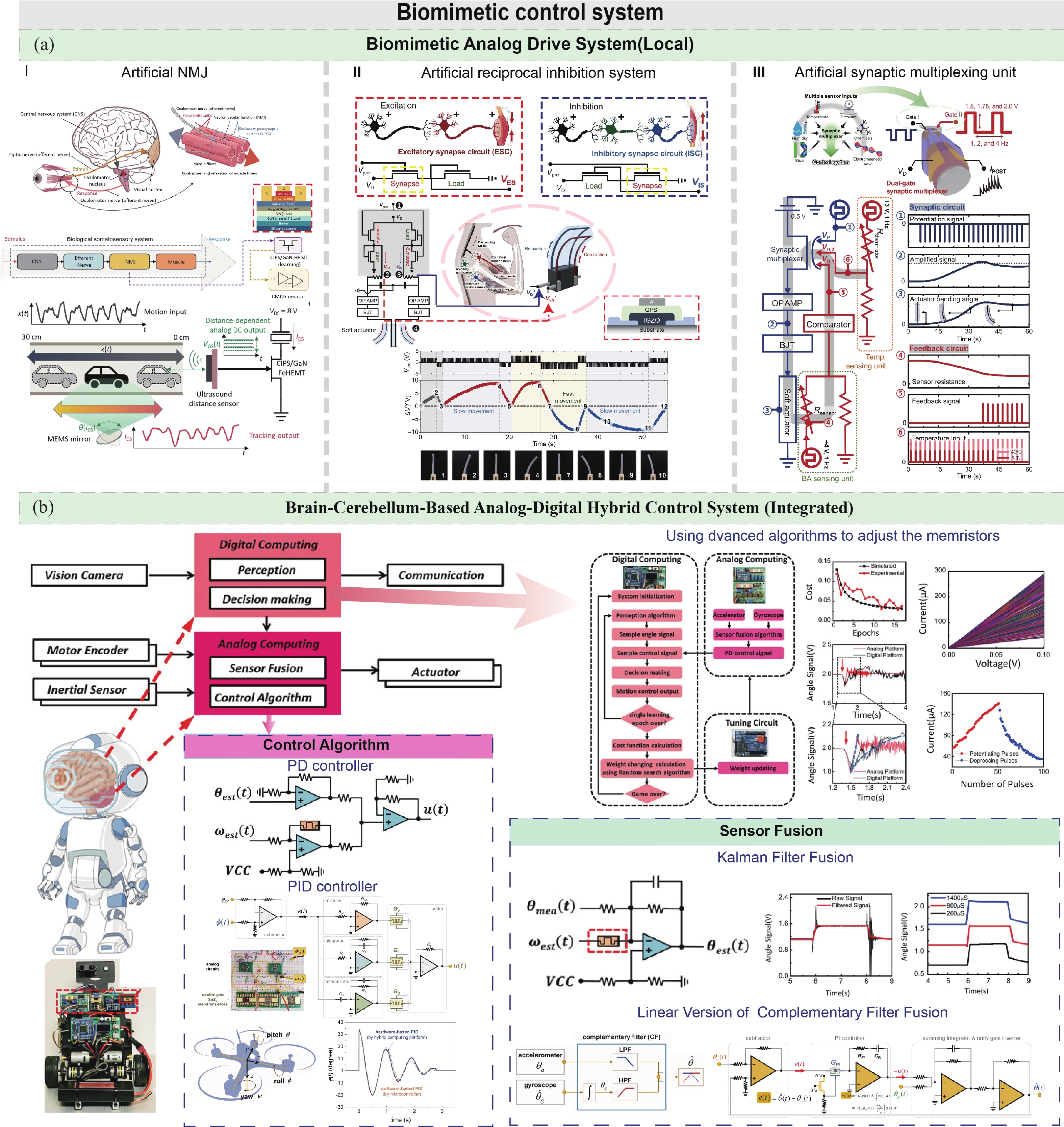| Citation: |
Xuemei Wang, Fan Yang, Qing Liu, Zien Zhang, Zhixing Wen, Jiangang Chen, Qirui Zhang, Cheng Wang, Ge Wang, Fucai Liu. Neuromorphic circuits based on memristors: endowing robots with a human-like brain[J]. Journal of Semiconductors, 2024, 45(6): 061301. doi: 10.1088/1674-4926/23120037
X M Wang, F Yang, Q Liu, Z E Zhang, Z X Wen, J G Chen, Q R Zhang, C Wang, G Wang, and F C Liu, Neuromorphic circuits based on memristors: endowing robots with a human-like brain[J]. J. Semicond., 2024, 45(6), 061301 doi: 10.1088/1674-4926/23120037
Export: BibTex EndNote
|
Neuromorphic circuits based on memristors: endowing robots with a human-like brain
doi: 10.1088/1674-4926/23120037
More Information-
Abstract
Robots are widely used, providing significant convenience in daily life and production. With the rapid development of artificial intelligence and neuromorphic computing in recent years, the realization of more intelligent robots through a profound intersection of neuroscience and robotics has received much attention. Neuromorphic circuits based on memristors used to construct hardware neural networks have proved to be a promising solution of shattering traditional control limitations in the field of robot control, showcasing characteristics that enhance robot intelligence, speed, and energy efficiency. Starting with introducing the working mechanism of memristors and peripheral circuit design, this review gives a comprehensive analysis on the biomimetic information processing and biomimetic driving operations achieved through the utilization of neuromorphic circuits in brain-like control. Four hardware neural network approaches, including digital-analog hybrid circuit design, novel device structure design, multi-regulation mechanism, and crossbar array, are summarized, which can well simulate the motor decision-making mechanism, multi-information integration and parallel control of brain at the hardware level. It will be definitely conductive to promote the application of memristor-based neuromorphic circuits in areas such as intelligent robotics, artificial intelligence, and neural computing. Finally, a conclusion and future prospects are discussed. -
References
[1] Yang G Z, Bellingham J, Dupont P E, et al. The grand challenges of science robotics. Sci Robot, 2018, 3, eaar7650 doi: 10.1126/scirobotics.aar7650[2] Soto F, Karshalev E, Zhang F Y, et al. Smart materials for microrobots. Chem Rev, 2022, 122, 5365 doi: 10.1021/acs.chemrev.0c00999[3] Dorigo M, Theraulaz G, Trianni V. Swarm robotics: Past, present, and future. Proc IEEE, 2021, 109, 1152 doi: 10.1109/JPROC.2021.3072740[4] Dupont P E, Nelson B J, Goldfarb M, et al. A decade retrospective of medical robotics research from 2010 to 2020. Sci Robot, 2021, 6, eabi8017 doi: 10.1126/scirobotics.abi8017[5] Yang J C, Mun J, Kwon S Y, et al. Electronic skin: Recent progress and future prospects for skin-attachable devices for health monitoring, robotics, and prosthetics. Adv Mater, 2019, 31, e1904765 doi: 10.1002/adma.201904765[6] Sandamirskaya Y, Kaboli M, Conradt J, et al. Neuromorphic computing hardware and neural architectures for robotics. Sci Robot, 2022, 7, eabl8419 doi: 10.1126/scirobotics.abl8419[7] Gupta J, Koppad D. Artificial neural network hardware implementation: Recent trends and applications. International Conference On Computational Vision and Bio Inspired Computing. Cham: Springer, 2020, 345 doi: 10.1007/978-3-030-37218-7_40[8] Raymond J L, Lisberger S G, Mauk M D. The cerebellum: A neuronal learning machine? Science, 1996, 272, 1126 doi: 10.1126/science.272.5265.1126[9] Buonomano D V, Maass W. State-dependent computations: Spatiotemporal processing in cortical networks. Nat Rev Neurosci, 2009, 10, 113 doi: 10.1038/nrn2558[10] Mehonic A, Kenyon A J. Brain-inspired computing needs a master plan. Nature, 2022, 604, 255 doi: 10.1038/s41586-021-04362-w[11] Schuman C D, Kulkarni S R, Parsa M, et al. Opportunities for neuromorphic computing algorithms and applications. Nat Comput Sci, 2022, 2, 10 doi: 10.1038/s43588-021-00184-y[12] Wang X L, Fung C C, Guan S B, et al. Perisaccadic receptive field expansion in the lateral intraparietal area. Neuron, 2016, 90, 400 doi: 10.1016/j.neuron.2016.02.035[13] Cui H. From intention to action: Hierarchical sensorimotor transformation in the posterior parietal cortex(12). eNeuro, 2014, 1, 0017 doi: 10.1523/eneuro.0017-14.2014[14] Carmeli C. Assessing cooperative behavior in dynamical networks with applications to brain data. PhD Dissertation, École Polytechnique Fédérale de Lausanne, 2006 doi: 10.5075/epfl-thesis-3651[15] Salvatori T, Song Y, Hong Y, et al. Associative memories via predictive coding. Neural Information Processing Systems, 2021, 34, 3874 doi: 10.48550/arXiv.2109.08063[16] Hung S C, Carrasco M. Feature-based attention enables robust, long-lasting location transfer in human perceptual learning. Sci Rep, 2021, 11, 13914 doi: 10.1038/s41598-021-93016-y[17] Zhao F F, Zeng Y, Xu B. A brain-inspired decision-making spiking neural network and its application in unmanned aerial vehicle. Front Neurorobot, 2018, 12, 56 doi: 10.3389/fnbot.2018.00056[18] Wang C Y, Shi G, Qiao F, et al. Research progress in architecture and application of RRAM with computing-in-memory. Nanoscale Adv, 2023, 5, 1559 doi: 10.1039/D3NA00025G[19] Nie Y Z, Ren T, Shi Z. The developments and applications of brain-like computing chips. Proc SPIE 12176, International Conference on Algorithms, Microchips and Network Applications, 2022, 12176, 272 doi: 10.1117/12.2636417[20] Zou X Q, Xu S, Chen X M, et al. Breaking the von Neumann bottleneck: Architecture-level processing-in-memory technology. Sci China Inf Sci, 2021, 64, 160404 doi: 10.1007/s11432-020-3227-1[21] Milde M B, Blum H, Dietmüller A, et al. Obstacle avoidance and target acquisition for robot navigation using a mixed signal analog/digital neuromorphic processing system. Front Neurorobot, 2017, 11, 28 doi: 10.3389/fnbot.2017.00028[22] Liu S L, Du Z D, Tao J H, et al. Cambricon: an instruction set architecture for neural networks. 2016 ACM/IEEE 43rd Annual International Symposium on Computer Architecture (ISCA), 2016, 393 doi: 10.1109/isca.2016.42[23] Vohra S K, Thomas S A, Sakare M, et al. CMOS circuit implementation of spiking neural network for pattern recognition using on-chip unsupervised STDP learning. arXiv: 2204.04430[24] Li X Y, Tang J S, Zhang Q T, et al. Power-efficient neural network with artificial dendrites. Nat Nanotechnol, 2020, 15, 776 doi: 10.1038/s41565-020-0722-5[25] Yuan R, Tiw P J, Cai L, et al. A neuromorphic physiological signal processing system based on VO2 memristor for next-generation human-machine interface. Nat Commun, 2023, 14, 3695 doi: 10.1038/s41467-023-39430-4[26] Rao A, Plank P, Wild A, et al. A long short-term memory for AI applications in spike-based neuromorphic hardware. Nat Mach Intell, 2022, 4, 467 doi: 10.1038/s42256-022-00480-w[27] Jeong D S, Kim I, Ziegler M, et al. Towards artificial neurons and synapses: A materials point of view. RSC Adv, 2013, 3, 3169 doi: 10.1039/c2ra22507g[28] Yang X X, Taylor B, Wu A L, et al. Research progress on memristor: From synapses to computing systems. IEEE Trans Circuits Syst I Regul Pap, 2022, 69, 1845 doi: 10.1109/TCSI.2022.3159153[29] Kim S J, Kim S B, Jang H W. Competing memristors for brain-inspired computing. iScience, 2020, 24, 101889 doi: 10.1016/j.isci.2020.101889[30] Burr G W, Shelby R M, Sebastian A, et al. Neuromorphic computing using non-volatile memory. Adv Phys X, 2017, 2, 89 doi: 10.1080/23746149.2016.1259585[31] Zidan M A, Strachan J P, Lu W D. The future of electronics based on memristive systems. Nat Electron, 2018, 1, 22 doi: 10.1038/s41928-017-0006-8[32] Yeşil A, Babacan Y, Kaçar F. A new DDCC based memristor emulator circuit and its applications. Microelectron J, 2014, 45, 282 doi: 10.1016/j.mejo.2014.01.011[33] Pershin Y V, Di Ventra M. Memcomputing and swarm intelligence. arXiv, 2014, 1408.6741 doi: 10.48550/arXiv.1408.6741[34] Babacan Y, Yesil A, Tozlu O F, et al. Investigation of STDP mechanisms for memristor circuits. AEU Int J Electron Commun, 2022, 151, 154230 doi: 10.1016/j.aeue.2022.154230[35] Dong Z K, Ji X Y, Zhou G D, et al. Multimodal neuromorphic sensory-processing system with memristor circuits for smart home applications. IEEE Trans Ind Appl, 2023, 59, 47 doi: 10.1109/TIA.2022.3188749[36] Innocenti G, Di Marco M, Tesi A, et al. Memristor circuits for simulating neuron spiking and burst phenomena. Front Neurosci, 2021, 15, 681035 doi: 10.3389/fnins.2021.681035[37] Chen C S, He Y L, Mao H W, et al. A photoelectric spiking neuron for visual depth perception. Adv Mater, 2022, 34, e2201895 doi: 10.1002/adma.202201895[38] Beck M E, Shylendra A, Sangwan V K, et al. Spiking neurons from tunable Gaussian heterojunction transistors. Nat Commun, 2020, 11, 1565 doi: 10.1038/s41467-020-15378-7[39] Kim H, Sah M P, Yang C J, et al. Memristor emulator for memristor circuit applications. IEEE Trans Circuits Syst I Regul Pap, 2012, 59, 2422 doi: 10.1109/TCSI.2012.2188957[40] Stadelmann C, Timmler S, Barrantes-Freer A, et al. Myelin in the central nervous system: Structure, function, and pathology. Physiol Rev, 2019, 99, 1381 doi: 10.1152/physrev.00031.2018[41] Kang Y J, Xue Y Q, Shin J H, et al. Human mini-brains for reconstituting central nervous system disorders. Lab Chip, 2023, 23, 964 doi: 10.1039/D2LC00897A[42] Pei Y F, Yan L, Wu Z H, et al. Artificial visual perception nervous system based on low-dimensional material photoelectric memristors. ACS Nano, 2021, 15, 17319 doi: 10.1021/acsnano.1c04676[43] Won U Y, Vu Q A, Park S B, et al. Multi-neuron connection using multi-terminal floating-gate memristor for unsupervised learning. Nat Commun, 2023, 14, 3070 doi: 10.1038/s41467-023-38667-3[44] Chen B Y, Yang H, Song B X, et al. A memristor-based hybrid analog-digital computing platform for mobile robotics. Sci Robot, 2020, 5, eabb6938 doi: 10.1126/scirobotics.abb6938[45] Kim S, Kim S, Ho D H, et al. Neurorobotic approaches to emulate human motor control with the integration of artificial synapse. Sci Adv, 2022, 8, eabo3326 doi: 10.1126/sciadv.abo3326[46] Zhang W B, Yao P, Gao B, et al. Edge learning using a fully integrated neuro-inspired memristor chip. Science, 2023, 381, 1205 doi: 10.1126/science.ade3483[47] Liu Z C, Wang L. Applications of phase change materials in electrical regime from conventional storage memory to novel neuromorphic computing. IEEE Access, 2020, 8, 76471 doi: 10.1109/ACCESS.2020.2990536[48] Xu M, Mai X L, Lin J, et al. Recent advances on neuromorphic devices based on chalcogenide phase-change materials. Adv Funct Materials, 2020, 30, 2003419 doi: 10.1002/adfm.202003419[49] Hansen M, Ziegler M, Kolberg L, et al. A double barrier memristive device. Sci Rep, 2015, 5, 13753 doi: 10.1038/srep13753[50] Ye J T, Inoue S, Kobayashi K, et al. Liquid-gated interface superconductivity on an atomically flat film. Nat Mater, 2010, 9, 125 doi: 10.1038/nmat2587[51] Sun W, Gao B, Chi M F, et al. Understanding memristive switching via in situ characterization and device modeling. Nat Commun, 2019, 10, 3453 doi: 10.1038/s41467-019-11411-6[52] Dananjaya P A, Gopalakrishnan R, Lew W S. RRAM-based neuromorphic computing systems. Emerging Non-volatile Memory Technologies. Singapore: Springer, 2021, 383 doi: 10.1007/978-981-15-6912-8_12[53] Marinella M J. Emerging resistive switching memory technologies: Overview and current status.2014 IEEE International Symposium on Circuits and Systems (ISCAS). Melbourne, VIC, Australia. IEEE, 2014, 830 doi: 10.1109/iscas.2014.6865264[54] Chen W, Song L, Wang S, et al. Essential characteristics of memristors for neuromorphic computing. Adv Elect Materials, 2022, 9, 2200833 doi: 10.1002/aelm.202200833[55] Xue F, He X, Wang Z Y, et al. Giant ferroelectric resistance switching controlled by a modulatory terminal for low-power neuromorphic In-memory computing. Adv Mater, 2021, 33, e2008709 doi: 10.1002/adma.202008709[56] Zhu X J, Li D, Liang X G, et al. Ionic modulation and ionic coupling effects in MoS2 devices for neuromorphic computing. Nat Mater, 2019, 18, 141 doi: 10.1038/s41563-018-0248-5[57] Grollier J, Querlioz D, Camsari K Y, et al. Neuromorphic spintronics. Nat Electron, 2020, 3, 360 doi: 10.1038/s41928-019-0360-9[58] Ielmini D, Wong H S P. In-memory computing with resistive switching devices. Nat Electron, 2018, 1, 333 doi: 10.1038/s41928-018-0092-2[59] Marković D, Mizrahi A, Querlioz D, et al. Physics for neuromorphic computing. Nat Rev Phys, 2020, 2, 499 doi: 10.1038/s42254-020-0208-2[60] van de Burgt Y, Melianas A, Keene S T, et al. Organic electronics for neuromorphic computing. Nat Electron, 2018, 1, 386 doi: 10.1038/s41928-018-0103-3[61] Sangwan V K, Hersam M C. Neuromorphic nanoelectronic materials. Nat Nanotechnol, 2020, 15, 517 doi: 10.1038/s41565-020-0647-z[62] Kumar S, Wang X X, Strachan J P, et al . Dynamical memristors for higher-complexity neuromorphic computing. Nat Rev Mater, 2022, 7, 575 doi: 10.1038/s41578-022-00434-z[63] Shastri B J, Tait A N, Ferreira de Lima T, et al. Photonics for artificial intelligence and neuromorphic computing. Nat Photonics, 2021, 15, 102 doi: 10.1038/s41566-020-00754-y[64] Xu M Y, Chen X R, Guo Y H, et al. Reconfigurable neuromorphic computing: Materials, devices, and integration. Adv Mater, 2023, 35, e2301063 doi: 10.1002/adma.202301063[65] Yang C S, Shang D S, Liu N, et al. A synaptic transistor based on quasi-2D molybdenum oxide. Adv Mater, 2017, 29, 1700906 doi: 10.1002/adma.201700906[66] Yang Y K, Pan C, Wang C Y, et al. In-sensor dynamic computing for intelligent machine vision. Nat Electron, 2024, 7, 225 doi: 10.1038/s41928-024-01124-0[67] Wang C, Yang Z Z, Wang S, et al. A braitenberg vehicle based on memristive neuromorphic circuits. Adv Intell Syst, 2020, 2, 1900103 doi: 10.1002/aisy.201900103[68] He K, Liu Y Q, Yu J C, et al. Artificial neural pathway based on a memristor synapse for optically mediated motion learning. ACS Nano, 2022, 16, 9691 doi: 10.1021/acsnano.2c03100[69] Shi Y H, Hua Q L, Dong Z L, et al. Neuro-inspired thermoresponsive nociceptor for intelligent sensory systems. Nano Energy, 2023, 113, 108549 doi: 10.1016/j.nanoen.2023.108549[70] He Y L, Nie S, Liu R, et al. Spatiotemporal information processing emulated by multiterminal neuro-transistor networks. Adv Mater, 2019, 31, e1900903 doi: 10.1002/adma.201900903[71] Roe D G, Ho D H, Choi Y Y, et al. Humanlike spontaneous motion coordination of robotic fingers through spatial multi-input spike signal multiplexing. Nat Commun, 2023, 14, 5 doi: 10.1038/s41467-022-34324-3[72] Mo W A, Ding G L, Nie Z H, et al. Spatiotemporal modulation of plasticity in multi-terminal erminal tactile synaptic transistor. Adv Electron Mater, 2022, 9, 2200733 doi: 10.1002/aelm.202200733[73] Leng Y B, Zhang Y Q, Lv Z Y, et al. Recent progress in multiterminal memristors for neuromorphic applications. Adv Elect Materials, 2023, 9, 2300108 doi: 10.1002/aelm.202300108[74] Cai F X, Correll J M, Lee S H, et al. A fully integrated reprogrammable memristor–CMOS system for efficient multiply–accumulate operations. Nat Electron, 2019, 2, 290 doi: 10.1038/s41928-019-0270-x[75] Wang S, Wang C Y, Wang P F, et al. Networking retinomorphic sensor with memristive crossbar for brain-inspired visual perception. Natl Sci Rev, 2020, 8, nwaa172 doi: 10.1093/nsr/nwaa172[76] Yu R J, Zhang X H, Gao C S, et al. Low-voltage solution-processed artificial optoelectronic hybrid-integrated neuron based on 2D MXene for multi-task spiking neural network. Nano Energy, 2022, 99, 107418 doi: 10.1016/j.nanoen.2022.107418[77] Wei Y N, Liu Y X, Lin Q J, et al. Organic optoelectronic synapses for sound perception. Nanomicro Lett, 2023, 15, 133 doi: 10.1007/s40820-023-01116-3[78] Wang C, Liang S J, Wang C Y, et al. Scalable massively parallel computing using continuous-time data representation in nanoscale crossbar array. Nat Nanotechnol, 2021, 16, 1079 doi: 10.1038/s41565-021-00943-y[79] Yu R J, Li E L, Wu X M, et al. Electret-based organic synaptic transistor for neuromorphic computing. CS Appl Mater Interfaces, 2020, 12, 15446 doi: 10.1021/acsami.9b22925[80] Rodder M A, Vasishta S, Dodabalapur A. Double-gate MoS2 field-effect transistor with a multilayer graphene floating gate: A versatile device for logic, memory, and synaptic applications. ACS Appl Mater Interfaces, 2020, 12, 33926 doi: 10.1021/acsami.0c08802[81] Park Y J, Ro Y G, Shin Y E, et al. Multi-layered triboelectric nanogenerators with controllable multiple spikes for low-power artificial synaptic devices. Adv Sci, 2023, 10, e2304598 doi: 10.1002/advs.202304598[82] Ho D H, Roe D G, Choi Y Y, et al. Non-von Neumann multi-input spike signal processing enabled by an artificial synaptic multiplexer. Sci Adv, 2022, 8, eabn1838 doi: 10.1126/sciadv.abn1838[83] Krauhausen I, Koutsouras D A, Melianas A, et al. Organic neuromorphic electronics for sensorimotor integration and learning in robotics. Sci Adv, 2021, 7, eabl5068 doi: 10.1126/sciadv.abl5068[84] Jiang C P, Liu J Q, Ni Y, et al. Mammalian-brain-inspired neuromorphic motion-cognition nerve achieves cross-modal perceptual enhancement. Nat Commun, 2023, 14, 1344 doi: 10.1038/s41467-023-36935-w[85] Cao G M, Meng P, Chen J G, et al. 2D material based synaptic devices for neuromorphic computing. Adv Funct Materials, 2021, 31, 2005443 doi: 10.1002/adfm.202005443[86] Yang R, Terabe K, Liu G Q, et al. On-demand nanodevice with electrical and neuromorphic multifunction realized by local ion migration. ACS Nano, 2012, 6, 9515 doi: 10.1021/nn302510e[87] Ohno T, Hasegawa T, Tsuruoka T, et al. Short-term plasticity and long-term potentiation mimicked in single inorganic synapses. Nat Mater, 2011, 10, 591 doi: 10.1038/nmat3054[88] Pan X Q, Wang J J, Deng Z, et al. A memristor-based bioinspired multimodal sensory memory system for sensory adaptation of robots. Adv Intell Syst, 2022, 4, 2200031 doi: 10.1002/aisy.202200031[89] Liu F Y, Deswal S, Christou A, et al. Printed synaptic transistor-based electronic skin for robots to feel and learn. Sci Robot, 2022, 7, eabl7286 doi: 10.1126/scirobotics.abl7286[90] Zheng Q H, Zhou L X, Gu Y. Temporal synchrony effects of optic flow and vestibular inputs on multisensory heading perception. Cell Rep, 2021, 37, 109999 doi: 10.1016/j.celrep.2021.109999[91] Hecht D, Reiner M, Karni A. Multisensory enhancement: Gains in choice and in simple response times. Exp Brain Res, 2008,189, 133 doi: 10.1007/s00221-008-1410-0[92] You W D, Li F B, Liao L Q, et al. Data fusion of UWB and IMU based on unscented Kalman filter for indoor localization of quadrotor UAV. IEEE Access, 2020, 8, 64971 doi: 10.1109/ACCESS.2020.2985053[93] Yeong D J, Velasco-Hernandez G, Barry J, et al. Sensor and sensor fusion technology in autonomous vehicles: A review. Sensors, 2021, 21, 2140 doi: 10.3390/s21062140[94] Baines R, Zuliani F, Chennoufi N, et al. Multi-modal deformation and temperature sensing for context-sensitive machines. Nat Commun, 2023, 14, 7499 doi: 10.1038/s41467-023-42655-y[95] Wu X S, Wang S C, Huang W, et al. Wearable in-sensor reservoir computing using optoelectronic polymers with through-space charge-transport characteristics for multi-task learning. Nat Commun, 2023, 14, 468 doi: 10.1038/s41467-023-36205-9[96] Park I, Cho S. Fusion localization for indoor airplane inspection using visual inertial odometry and ultrasonic RTLS. Sci Rep, 2023, 13, 18117 doi: 10.1038/s41598-023-43425-y[97] Spruston N. Pyramidal neurons: Dendritic structure and synaptic integration. Nat Rev Neurosci, 2008, 9, 206 doi: 10.1038/nrn2286[98] Leugering J, Nieters P, Pipa G. Dendritic plateau potentials can process spike sequences across multiple time-scales. Front Cognit, 2023,2, 1044216 doi: 10.3389/fcogn.2023.1044216[99] Gilbert C D, Li W. Top-down influences on visual processing. Nat Rev Neurosci, 2013, 14, 350 doi: 10.1038/nrn3476[100] Wang W, Pedretti G, Milo V, et al. Learning of spatiotemporal patterns in a spiking neural network with resistive switching synapses. Sci Adv, 2018, 4, eaat4752 doi: 10.1126/sciadv.aat4752[101] Cassidy A S, Georgiou J, Andreou A G. Design of silicon brains in the nano-CMOS era: Spiking neurons, learning synapses and neural architecture optimization. Neural Netw, 2013, 45, 4 doi: 10.1016/j.neunet.2013.05.011[102] Diamond A, Knight R, Devereux D, et al. Anthropomimetic robots: Concept, construction and modelling. Int J Adv Rob Syst, 2012, 9, 209 doi: 10.5772/52421[103] Park M, Yang J Y, Yeom M J, et al. An artificial neuromuscular junction for enhanced reflexes and oculomotor dynamics based on a ferroelectric CuInP2S6/GaN HEMT. Sci Adv, 2023, 9, eadh9889 doi: 10.1126/sciadv.adh9889[104] Rehman S, Khan M F, Kim H D, et al. Analog-digital hybrid computing with SnS2 memtransistor for low-powered sensor fusion. Nat Commun, 2022, 13, 2804 doi: 10.1038/s41467-022-30564-5[105] Rehman S, Khan M F, Kim H D, et al. A self-tuning PID controller based on analog–digital hybrid computing with a double-gate SnS2 memtransistor. Nanoscale, 2023, 15, 13675 doi: 10.1039/D2NR06853B[106] Rehman S, Khan M, Kim H D, et al. Energy-efficient and reconfigurable complementary filter based on analog–digital hybrid computing with SnS2 memtransistor. Nano Energy, 2023, 109, 108333 doi: 10.1016/j.nanoen.2023.108333 -
Proportional views





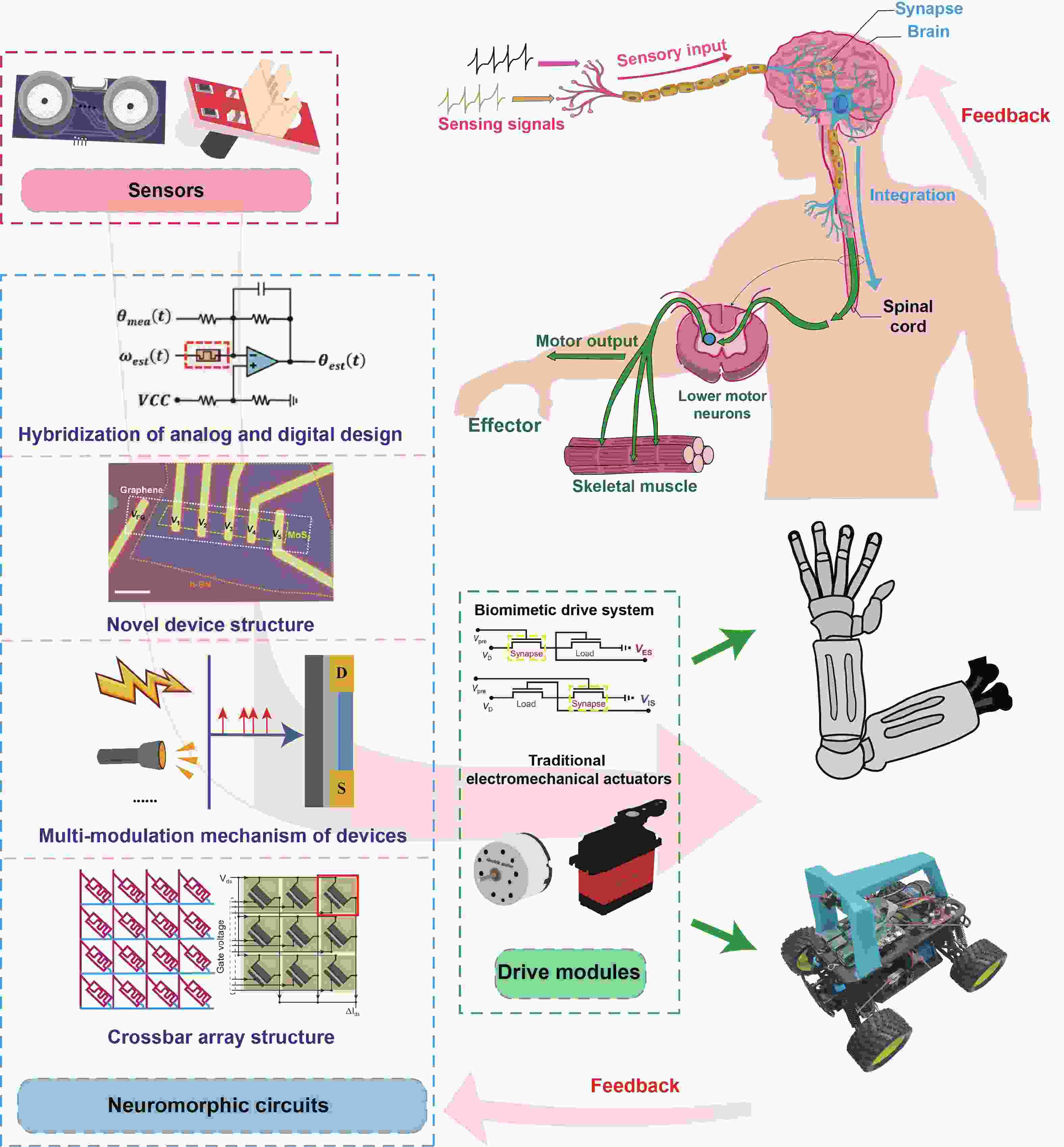
 DownLoad:
DownLoad:
